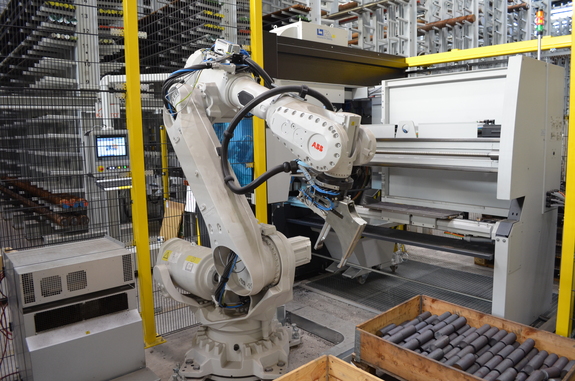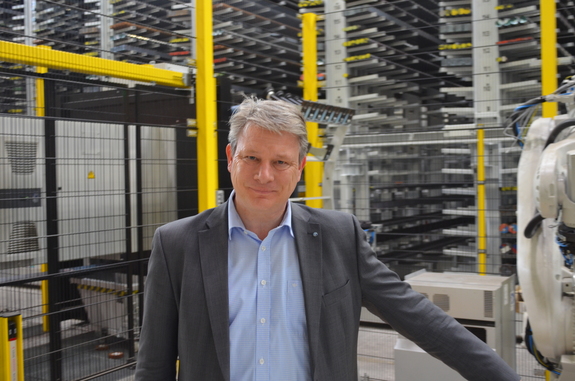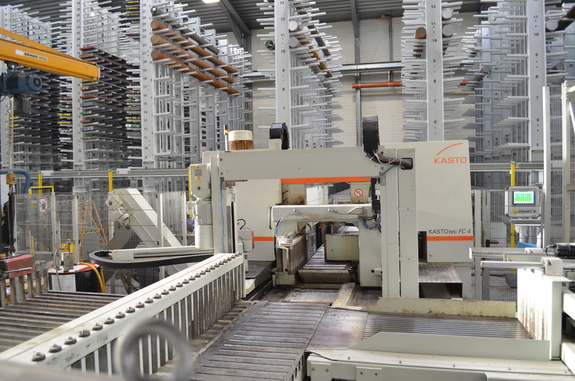
In order to meet the challenges of ever tougher international competition, the steel trading company Weser Stahl in Stuhr-Brinkum, Lower Saxony, consistently relies on automation. The heart of the internal logistics has recently been a combined warehouse-saw-robot system from Kasto.

© Kasto
Not all steel is the same: Today, there are more than 2,500 standardized grades worldwide, ranging from simple structural steel to high-quality special alloys. These are in turn available in a wide range of dimensions and geometries. This makes trading in steel a real challenge: if you want to be successful in an increasingly competitive international market, you have to be able to provide your customers with the material they need reliably and in the desired packaging at any time.
Weser Stahl Handelsgesellschaft is only too familiar with this task. The company, based in Stuhr-Brinkum near Bremen in Lower Saxony, has specialised in trading in hot-rolled and forged steel bars, steel tubes and bright steel for many years.
Weser Stahl is part of Westfälische Stahlgesellschaft, an owner-managed group of companies with four locations in Germany, which combines steel trading, bright steel production and materials analysis under one roof. The Stuhr site mainly supplies customers in northern Germany and Scandinavia. The Group sells around 250,000 tonnes of material per year, of which Weser Stahl accounts for around 30,000 tonnes.
Increasing order numbers and decreasing batch sizes
The proportion of machined products is particularly high: More than half of the deliveries leave the warehouse and production halls in Stuhr already cut to size – with an upward trend, as Dr. Markus Krummenerl, Managing Partner of Weser Stahl, notes: “Our customers are outsourcing more and more processing steps in order to save on their own capacities. Therefore, we are constantly expanding our portfolio in this area in order to be able to reliably fulfil as many wishes as possible.” However, this also means that orders are becoming more and more individual, explains Krummenerl: “The number of orders is increasing, while batch sizes are decreasing at the same time. This naturally presents our manufacturing and logistics processes with a major challenge.”
In order to cope with these, Weser Stahl relies on state-of-the-art machinery. Several band and circular saws are available for cutting the various materials. Kasto has been a supplier for many years: The machines of the manufacturer from Achern in southern Germany are established throughout the group due to their quality and performance. “We appreciate Kasto as a competent partner who always has a suitable solution up its sleeve, even for individual requirements,” reports Krummenerl. For this reason, those responsible at Weser Stahl also turned to the saw and storage technology specialist with another ambitious project.

© Kasto
Unmanned operation relieves employees
The aim was to automate the supply of the saws and to enable largely unmanned operation in order to cope with the increasing number of orders and to meet the ever more extensive processing requirements of the customers. “Another important aspect for us was occupational safety,” adds Krummenerl. “We wanted to make the environment more ergonomic for our employees and make their daily work easier – actively preventing accidents and injuries.”
Until now, the material has been transported to the saws manually by overhead crane – a time-consuming and not without danger for the rods and pipes, some of which weigh several tons. “We have therefore approached Kasto and asked them to come up with various solutions.”
Intensive calculations on the part of Kasto showed that a fully automatic cantilever bearing was best suited for this application. Weser Stahl therefore decided in favour of the Kastocenter varioplus 4 system: it offers space for materials up to seven metres in length with 1,398 compartments at a height of just under eight metres.
The usable loading height of the cantilever compartments is between 50 and 430 millimetres, the maximum load per compartment is four tonnes. The long goods are stored and retrieved by a storage and retrieval machine (SRM), which travels at a speed of up to 60 metres per minute above the racking block. Also connected to the warehouse are two fully automatic production circular saws of the Kastovariospeed type and a band saw of the Kastotec series.

© Kasto
Intelligent warehouse management saves time and distances
Around 20 percent of Weser Stahl’s stock is stored in the Kasto system. Which ones are decided by experience, explains Sales Manager Stieven Harder: “We know for which articles we frequently need cut-to-size parts, and we specifically store the materials to be sawn here.”
The long goods are usually delivered in bundles by truck, unloaded and stored with the aid of a transport vehicle. The Kastologic warehouse management software is responsible for selecting a suitable cantilever compartment. It ensures that the RBG works in a time- and path-optimized manner, thus keeping access times to a minimum.
“In addition, we have separate storage areas for bright steel and for rolled steel to protect against rust,” Harder continues. “The corresponding specifications are also stored in the software”. Kastologic is also connected to the higher-level ERP system at Weser Stahl via a specially created interface – this increases transparency and makes it easier to pass on order data.
The retrieved material is transported to the respective saw via roller conveyors. In front of it there is a changing station as an additional buffer to avoid waiting times. The two Kastovariospeed circular saws allow a cutting range of up to 150 millimetres, while the Kastotec FC 4 band saw is suitable for larger materials up to 430 millimetres in diameter. “This saw has been with us since before we built the warehouse,” Harder says. “Kasto then simply integrated them into the new system and also installed the two circular saws.”
Weser Stahl also relies on automation in terms of material removal: The Kastotec is equipped with a disk turning and stacking system, while the two Kastovariospeed saws are each equipped with an industrial robot that independently removes the sawn sections and stacks them on pallets according to the order.
The automated peripheral systems including the robot integration also come from Kasto and are adapted to the automatic saws and the storage system from the mechanics, the electrics up to the software.
“We have thus created a continuous material flow that can also function completely unmanned if required – and around the clock,” explains Harder. “This means a huge increase in efficiency and performance, as well as more ergonomic working conditions for our employees at the same time.”

© Kasto
RBG as a worldwide unique custom-made product
Remaining pieces are returned to storage via the conveyor system and the RBG. The latter has a special modification so that it can transport not only one, but also several rods at the same time. “This was not possible in the standard version, but Kasto modified the device according to our wishes – in its current form it is unique worldwide,” reports Stieven Harder, and Dr. Markus Krummenerl adds: “This example clearly shows how well Kasto responds to the individual requirements of its customers. “Regardless of whether it’s the implementation of special designs or the service support after commissioning: we feel very well looked after here all round.”
However, the joint path to more automation is not yet at an end: Weser Stahl and Kasto are currently planning, together with Jungheinrich, to connect the saws to a driverless transport system (AGV). This is to remove the pallets with the stacked sections from the work area of the Kastosort robots and make them available in the dispatch warehouse. “Kasto has already created the corresponding periphery for this,” shows Harder. “For example, the protective enclosure of each of the saws is equipped with a roller shutter and light barrier technology, through which the AGV can easily enter and exit.”
On the software side, too, the companies involved cooperate closely with each other to ensure the smooth interaction of all components. “In addition, we are already planning another warehouse with Kasto at our site in Plettenberg,” reports Krummenerl. “We are glad to have such a competent partner on our side, who supports us with reliable technology and fresh ideas.”
Web:
www.kasto.com



